Size: 83.4 x 83.1 x 4.4 mm
NTHK certified KANTEISHO ("Important Work"). In a custom wooden box. For information regarding shakoh tsuba see article 'Kirishitan Ikenie Tsuba by Fred Geyer at Kokusai Tosogu Kai; The 2nd International Convention & Exhibition, October 18-23, 2006, pp. 84-91.-
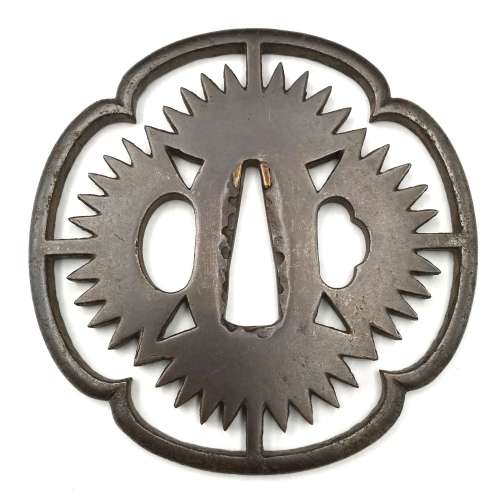 Iron tsuba of mokko form with slanting rays of light (shakoh) Christian motif (Jesuit's IHS symbol) in openwork (sukashi). Traditional description of this kind of design is called "tokei", or "clock gear". Owari school. Edo period.
Iron tsuba of mokko form with slanting rays of light (shakoh) Christian motif (Jesuit's IHS symbol) in openwork (sukashi). Traditional description of this kind of design is called "tokei", or "clock gear". Owari school. Edo period. -
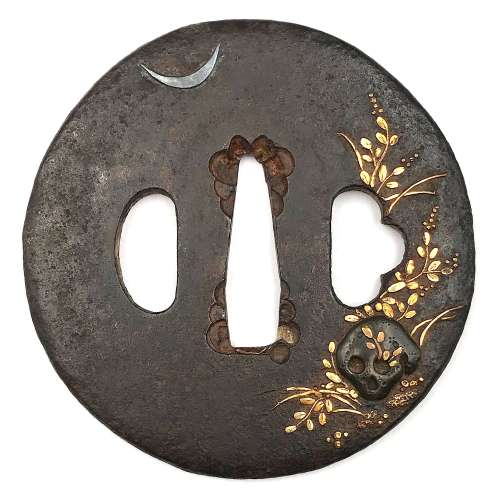 An iron tsuba of round shape inlaid with shakudō, gold, and silver with a motif of a weather-beaten (nozarashi) skull and grasses growing beside as well as through the eye-pit, and a crescent moon above the scene. Grasses on the reverse. Unsigned. Dimensions: 71.7 x 70.6 x 4.2 mm Reference: Skull, bones and grave markers SOLD
An iron tsuba of round shape inlaid with shakudō, gold, and silver with a motif of a weather-beaten (nozarashi) skull and grasses growing beside as well as through the eye-pit, and a crescent moon above the scene. Grasses on the reverse. Unsigned. Dimensions: 71.7 x 70.6 x 4.2 mm Reference: Skull, bones and grave markers SOLD -
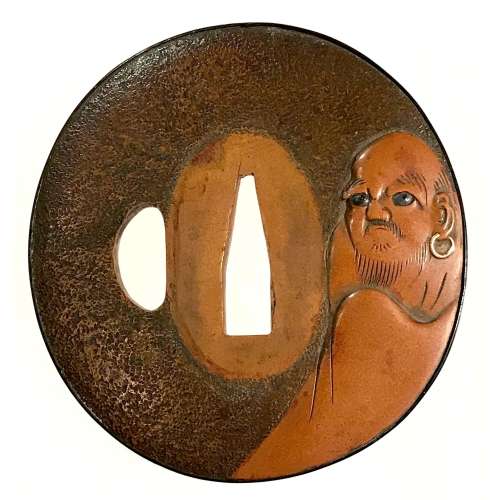
A copper tsuba with ishime-ji ground carved and polished (migaki-ji) with sitting Daruma; his eyes are inlaid with shakudo and he has a golden earring. The reverse carved with four characters: 廓 然 無 性 (Kakunen-mushō). It is a Zen proverb that goes back to Bodhidharma (Daruma), meaning "boundless expanse and nothing that can be called holy." [Markus Sesko translation]. Shakudo fukurin.
Unsigned.
Edo period (circa 1800). Dimensions: 68.2 x 65.5 x 4.8 (center) x 3.2 (rim) mm -
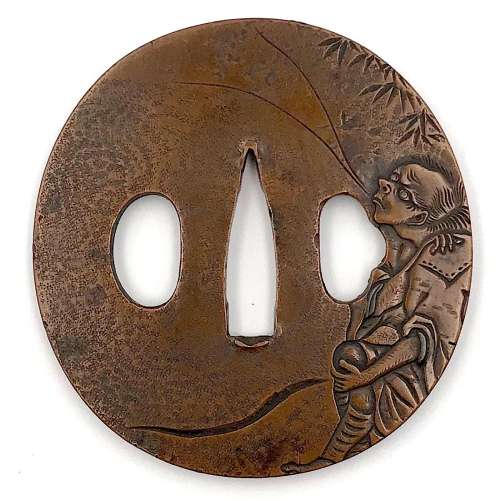
Copper tsuba of oval form carved in kebori and katakiribori with Tekkai Sennin sitting under bamboo on the face and with a pine tree on the back. Ishime-ji treated surface.
Signed on the reverse: Jōi (乗 意).
Edo period (First half of 18th century). Dimensions: 69.6 x 66.5 x 4.5 mm Sugiura Jōi (杉 浦 乗 意) was a master of Nara School in Edo; he was a student of Toshinaga [M. Sesko, 'Genealogies', p. 32]. "Sugiura Jōi (1701-1761) made many fuchigashira and kozuka, tsuba are rather rare." [M. Sesko, The Japanese toso-kinko Schools]. -
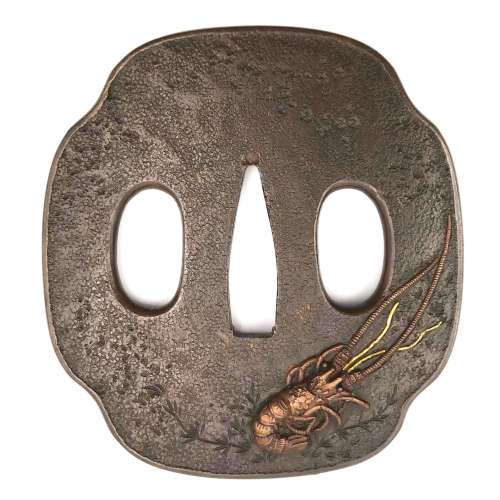
Bronze tsuba of mokkō form with narrow slightly raised rim carved in kebori with the sea weed and inlaid with a lobster (ebi) made of copper on the face and two sea shells made of shakudo on the back. Lobster's antennae inlaid in gold, and eyes inlaid in shakudo. Ishime-ji treated surface.
Unsigned.
Late Edo period (mid-19th century). Dimensions: 76.3 x 71.1 x 3.7 mm -

Iron tsuba of circular form with a branch of loquat (biwa) pierced in positive silhouette (ji-sukashi) and carved in marubori technique (marubori-sukashi). Kozuka and kogai hitsu-ana are plugged with shakudo.
Signature: Choshu Kawaji ju Hisatsugu saku. Chōshū school in Nagato province.
According to M. Sesko 'Genealogies' Hisatsugu was a 4th generation Kawaji School master from Chōshū (present day Nagato), with the name Gonbei, formerly Toramatsu, adopted son of Tomohisa (1687-1743) [page 117]. For Tomohisa work see TSU-0104 in this collection. -
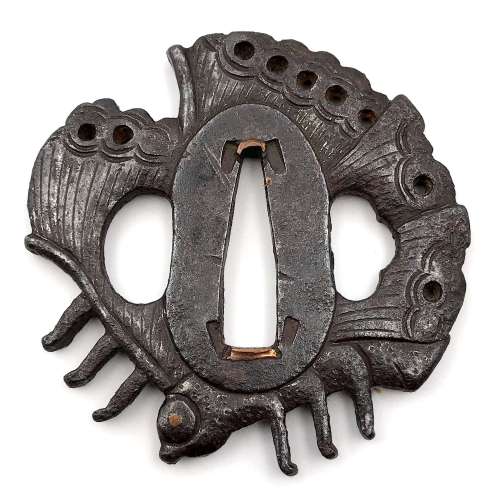 This tsuba is a cut from a typical Bizen Shōami butterfly tsuba (see TSU-0100 in this collection), which normally would have had a circular rim around the butterfly. In this particular example of altered guard we have both eyes of the insect (inlaid in brass or copper) intact. The kebori carving is more pronounced than in TSU-0100 example. Copper sekigane. Unsigned. Attributed to Bizen Shōami school, early Edo period (17th century). Dimensions: 64.7 x 63.7 x 5.2 mm References: see TSU-0100.
This tsuba is a cut from a typical Bizen Shōami butterfly tsuba (see TSU-0100 in this collection), which normally would have had a circular rim around the butterfly. In this particular example of altered guard we have both eyes of the insect (inlaid in brass or copper) intact. The kebori carving is more pronounced than in TSU-0100 example. Copper sekigane. Unsigned. Attributed to Bizen Shōami school, early Edo period (17th century). Dimensions: 64.7 x 63.7 x 5.2 mm References: see TSU-0100. -
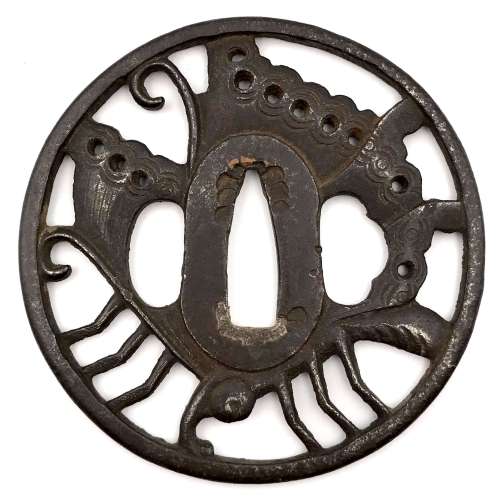 Iron tsuba of round form decorated with the design of a butterfly in openwork (sukashi) with details carved in kebori. Eyes inlaid in brass (one inlay is missing). Unsigned. Attributed to Bizen Shōami school, early Edo period (17th century). Dimensions: 80.4 x 80.6 x 4.4 mm References At Haynes Catalog #6, p. 18-19, Lot 30: "Famous Ikeda butterfly design" (Ikeda family of Inaba and Okayama, and at least 7 other families). Ca. 1700. Shōami of Kyoto, no doubt. Ht 8.2 cm, Th. 5 mm. ["Important tsuba, menuki, bokuto, woodblock prints, koshirae, sword pistol and kana mono". San Francisco, June 1-26, 1983. Catalog #6. Robert E. Haynes, Ltd.]Similar tsuba at Haynes Catalog #9, p.71, lot 143: the classic Shoami tsuba of the mon of the Ikeda family. This example, as most, seems to be made by the same hand as the others. See Haynes sale number 6, lot 30, for an identical example. The eye is brass. From an old French collection. Ht. 7.9 cm., Th. 5 mm.
Iron tsuba of round form decorated with the design of a butterfly in openwork (sukashi) with details carved in kebori. Eyes inlaid in brass (one inlay is missing). Unsigned. Attributed to Bizen Shōami school, early Edo period (17th century). Dimensions: 80.4 x 80.6 x 4.4 mm References At Haynes Catalog #6, p. 18-19, Lot 30: "Famous Ikeda butterfly design" (Ikeda family of Inaba and Okayama, and at least 7 other families). Ca. 1700. Shōami of Kyoto, no doubt. Ht 8.2 cm, Th. 5 mm. ["Important tsuba, menuki, bokuto, woodblock prints, koshirae, sword pistol and kana mono". San Francisco, June 1-26, 1983. Catalog #6. Robert E. Haynes, Ltd.]Similar tsuba at Haynes Catalog #9, p.71, lot 143: the classic Shoami tsuba of the mon of the Ikeda family. This example, as most, seems to be made by the same hand as the others. See Haynes sale number 6, lot 30, for an identical example. The eye is brass. From an old French collection. Ht. 7.9 cm., Th. 5 mm.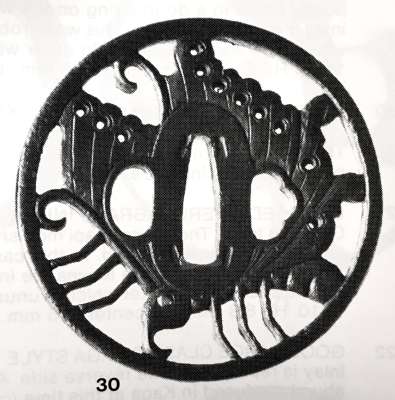
Haynes Catalog #6, lot 30.
Similar tsuba in the Randolph B. Caldwell Collection, 1994, page 24, №13: "A circular iron tsuba pierced in positive sukashi with a butterfly within an angular rim, details engraved. The eye inlaid in brass [in my specimen the inlay is missing on the omote side]. Unsigned. Bizen Shōami, Momoyama period. Dimensions: 8.0 x 8.2 x 0.5 cm. Similar example: Durand-Ruel, collection Ch. Gilloz, number 1302. [SV: that's possibly the 'old French collection' of Robert Haynes.]
Haynes Catalog #9, lot 143.
If we accept Haynes' theory regarding the genealogy and history of Bizen Shōami family, Momoyama period attribution would seem unlikely. I am leaning towards the early to mid 17th century.
Caldwell Collection, #13.
-
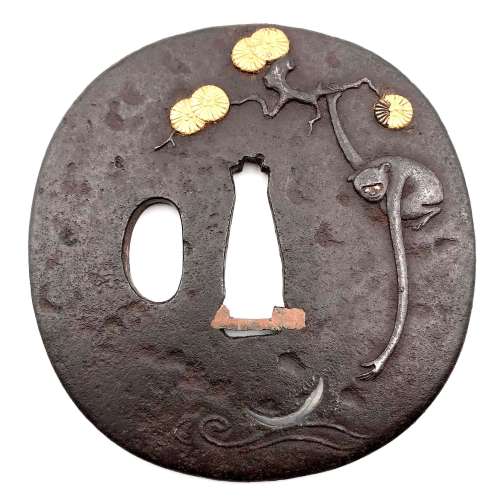 [SOLD]
[SOLD]Iron tsuba of slightly elongated round form carved and inlaid in gold and shibuichi with a long-armed monkey hanging from a pine tree branch reaching for the reflection of a crescent moon in the stream. A pine tree carved with details inlaid in gold on the reverse. The design seems to be inspired by Kaneie work (Compton III, p. 10, №6a; Tsuba no bi, 1947, p. 33, №56).
Dimensions: 76.8 x 74.2 x 3.6 mm. Mid-Edo period. Unsigned.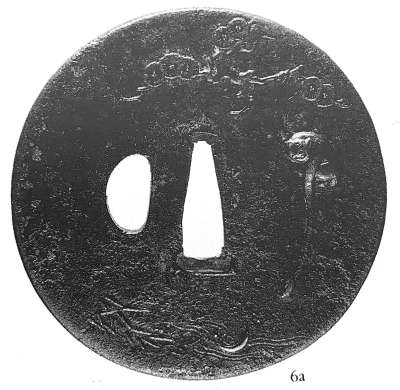
Compton III, p. 10, №6a

Tsuba no bi, 1947, p. 33, №56.
-
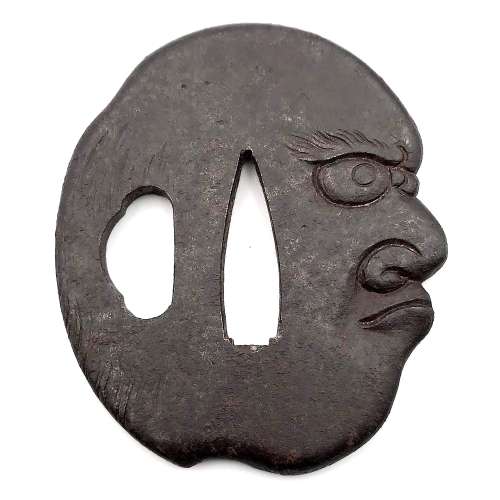 An iron tsuba in the shape of a bold or shaved human head in full round. Unsigned. Dimensions: 62.5 x 53.4 x 4.4 mm Iron, in the shape of a Ni O (Nio) head, in full round, the back flat chased as a pine forest. Signed : Miōchin Masatsugu in sosho. №38 in The Naunton Collection, 1912. There are a few tsuba of such design known. SOLDIron, a severed head. Signed: Takeaki of Kwaiyō. Ex Hawkshaw Collection [Plate VII]. Below written: Takurio, Suruga, 1118; Tamagawa, p. ; Tanaka, p. 168; Tanetora, 1894. №2729 in The Naunton Collection, 1912.
An iron tsuba in the shape of a bold or shaved human head in full round. Unsigned. Dimensions: 62.5 x 53.4 x 4.4 mm Iron, in the shape of a Ni O (Nio) head, in full round, the back flat chased as a pine forest. Signed : Miōchin Masatsugu in sosho. №38 in The Naunton Collection, 1912. There are a few tsuba of such design known. SOLDIron, a severed head. Signed: Takeaki of Kwaiyō. Ex Hawkshaw Collection [Plate VII]. Below written: Takurio, Suruga, 1118; Tamagawa, p. ; Tanaka, p. 168; Tanetora, 1894. №2729 in The Naunton Collection, 1912.
№38 Naunton Collection, 1912.
Reference to Hawkshaw Collection [Plate VII] happened to be not exact; it is Plate VIII, №236. It is clearly not the Hawkshaw piece (different facial expression, signle hitsu-ana, no plug. Description at Hawkshaw, 1910, reads: Iron, in the shape of a man's head, severed at the neck, the forehead in three wrinkles, the mouth hard-set and drooping, the eyes open, inlaid brass with shakudo pupils. Signed: Shoami; dated second year of Shoho, first month [SV: December 1644 through February 1648].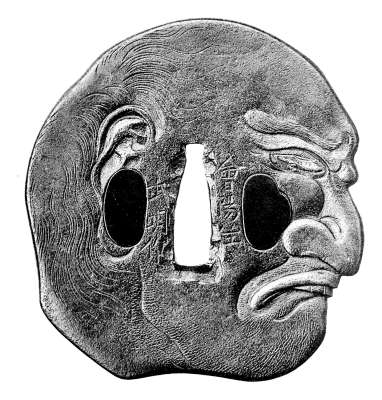
№2729 Naunton Collection, 1912.

№236 Hawkshaw Collection, 1910.
-
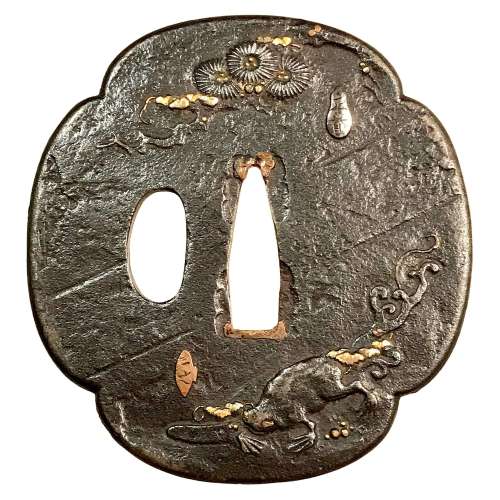
Iron tsuba of mokkō-form with a pine and a frog on the face and a snail on the back, carved and inlaid with gold. Each figurative element of the design is signed on three inlaid cartouches: Masaharu (正春), Kazuyuki (一之), and Yoshikazu (良一) [read by Markus Sesko]. Snake, snail, and frog together make a design called "SANSUKUMI" - Three Cringing Ones [Merrily Baird]. The snail can poison the snake, the frog eats the snail, and the snake eats the frog. It's unclear whether the pine replaces the snake on this tsuba, or the snake is hiding in the pine? Anyway, the frog and the snail are clearly represented. "Maybe we have here a joint work with Masaharu (the silver cartouche next to the pine) being the master and making the plate and Kazuyuki and Yoshikazu as his students carving out the frog and the snail respectively". Copper sekigane.
Dimensions: 70.9 x 67.2 x 3.0 mm. Edo period (18th century).Markus Sesko writes: "I agree, the frog and the snail most likely allude to the san-sukumi motif. It is possible that we have here an artist's choice to deliberately leave out the snake, maybe he thought that the motif is already obvious and there is no need to add a snake to make it clear that the tsuba shows the san-sukumi motif." [Markus Sesko].
Kazuyuki (一之): adopted son of Kumagai Yoshiyuki, student of Ichijō (Gotō-Ichijō Scool) [M. Sesko 'Genealogies', page 19.] Masaharu (正春): Kasuya fam., student of Masamichi (1707-1757) who was the 4th generation Nomura School master in Edo. [M. Sesko 'Genealogies', page 49.] -
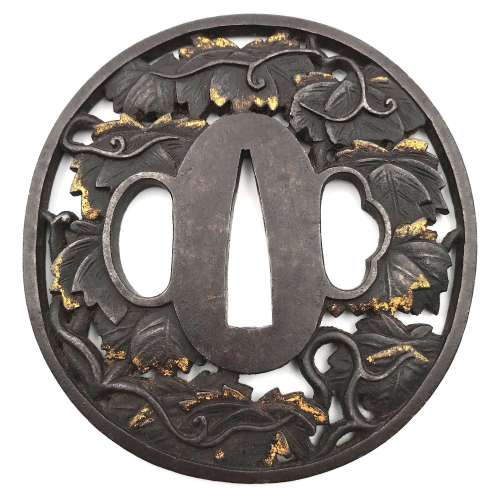
An iron tsuba of slightly vertically elongated circular form carved and pierced with a mass of ivy (tsuta) leaves and tendrils, details damascened with gold in nunome-zōgan technique. Hitsu-ana with raised rim.
Unsigned.
Chōshū school.Height: 72.0 mm; width: 69.0 mm; thickness: 4.7 mm; Weight: 92 g.
According to John W. Dower, "ivy bears fairly close resemblance to both maple leaf and grape leaf". However, I consider this tsuba decorated with ivy leaves for several reasons, such as the lack of racemations in the presence of tendrils. -
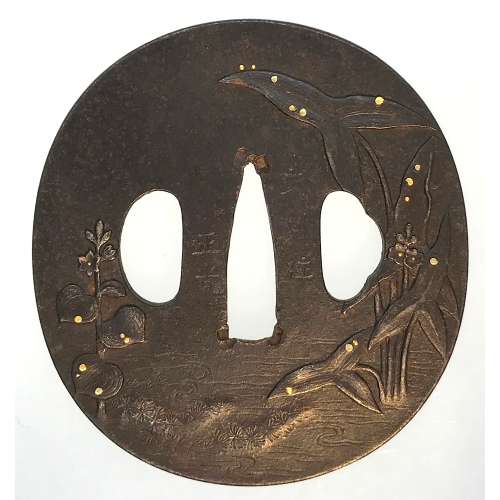
An iron tsuba of oval form decorated with a water plantain (omodaka) carved in low relief and water drops inlaid in gold.
Signed: Bushū jū Masamitsu.
Bushū-Itō school.Height: 71.8; Width: 67.3; Thickness: 3.6; Weight: 96 g.
Mid to late Edo period; 18th-19th century.
There were several tsuba artists with the name of Masamitsu. The one who worked with iron and spelled [正光] is mentioned at Markus Sesko's 'Genealogies' on page 106 in Akasaka School of Edo section as Masamitsu Gorōbei , student of Tadatoki, 4th generation Akasaka master. The name is not mentioned at Torigoye/Haynes 'Tsuba. An Aesthetic Study' in the list of Bushū-Itō family masters on page 181. -
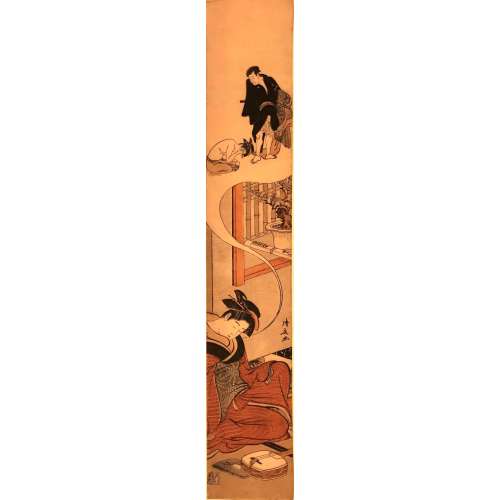 Torii Kiyonaga (1752-1815) Color woodblock print: hashira-e, 68.9 x 12.1 cm. DATE: 1783. Signed: Kiyonaga ga Publisher: Eijudō (Nishimuraya Yohachi) "Young musician dreams of being abducted by a ruffian. Long hours on duty have exhausted this young musician who sits sleeping with her shamisen and book placed on the ground in front of her. In her dream, she is being abducted by a ruffian who has stripped her of her clothing" [LIB-1474.2018: Important Japanese prints from the collection of Henry Steiner. Catalogue № 14. — NY: Sebastian Izzard LLC, 2018.]
Torii Kiyonaga (1752-1815) Color woodblock print: hashira-e, 68.9 x 12.1 cm. DATE: 1783. Signed: Kiyonaga ga Publisher: Eijudō (Nishimuraya Yohachi) "Young musician dreams of being abducted by a ruffian. Long hours on duty have exhausted this young musician who sits sleeping with her shamisen and book placed on the ground in front of her. In her dream, she is being abducted by a ruffian who has stripped her of her clothing" [LIB-1474.2018: Important Japanese prints from the collection of Henry Steiner. Catalogue № 14. — NY: Sebastian Izzard LLC, 2018.]The Japanese Pillar Print. Hashira-e. Jacob Pins. Foreword by Roger Keyes. Robert G. Sawers Publishing, London, 1982 [LIB-1543.2018 in this collection] -> page 262 №703: A young woman dreaming of rape and robbery. 1783. Hirano.
MFA: ACCESSION NUMBER 21.5546: Young Woman Music Teacher Dreaming of a Robbery [追剥の夢を見る三味線師匠]. Edo period, about 1783 (Tenmei 3). Artist Torii Kiyonaga (1752–1815), Publisher Nishimuraya Yohachi (Eijudô). Harvard Museums Object Number 1916.586: Female Musician Dreaming of Robbery. Edo period, circa 1783. Torii Kiyonaga, Japanese (1752 - 1815) . Published by Nishimuraya Yohachi. -
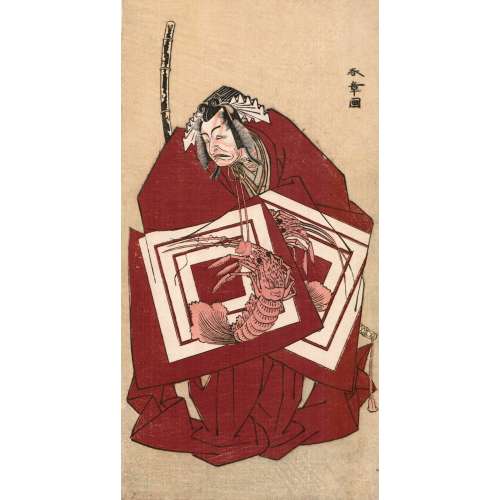 Ichikawa Ebizō III (Matsumoto Kōshirō II, Ichikawa Danjūrō IV, 1711-1778) probably shown as Shinozuka Gorō in the Shibaraku scene of the play Ōyoroi Ebidō Shinozuka, performed at the Nakamura Theater in the 11th month of 1772 (Meiwa 9). This was the occasion when he celebrated his name change, from Matsumoto Kōshirō II to Ichikawa Ebizō III. The lobster or giant shrimp (ebi) upon the Ichikawa family crest (three concentric squares - three measures of rice) on his garment underscores the fact of the name change (ebizō).
Ichikawa Ebizō III (Matsumoto Kōshirō II, Ichikawa Danjūrō IV, 1711-1778) probably shown as Shinozuka Gorō in the Shibaraku scene of the play Ōyoroi Ebidō Shinozuka, performed at the Nakamura Theater in the 11th month of 1772 (Meiwa 9). This was the occasion when he celebrated his name change, from Matsumoto Kōshirō II to Ichikawa Ebizō III. The lobster or giant shrimp (ebi) upon the Ichikawa family crest (three concentric squares - three measures of rice) on his garment underscores the fact of the name change (ebizō). -
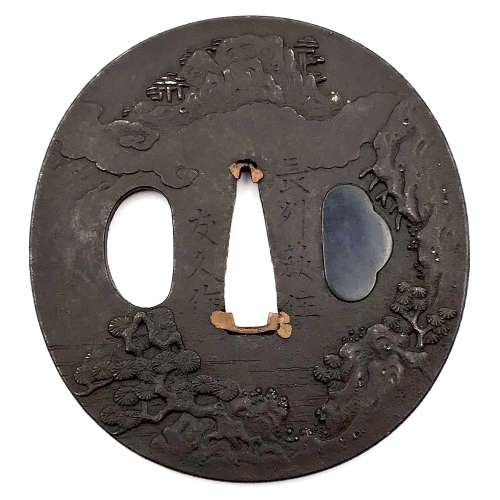
Iron tsuba of oval form carved with a landscape motif. Kogai-hitsu-ana plugged with shakudo. Sekigane of copper.
Signed: Chōshū Hagi-jū Tomohisa saku (長州萩住友久作).
Tomohisa, adopted son of Rokurō'emon, was 3rd generation master of Kawaji School from Hagi in Nagato (Chōshū), lived 1687-1743 [M. Sesko 'Genealogies', page 117].
Edo period, circa 1700. Dimensions: 71.1 x 66.8 x 2.9 mm For his adopted son Hisatsugu work see TSU-0103 in this collection. -
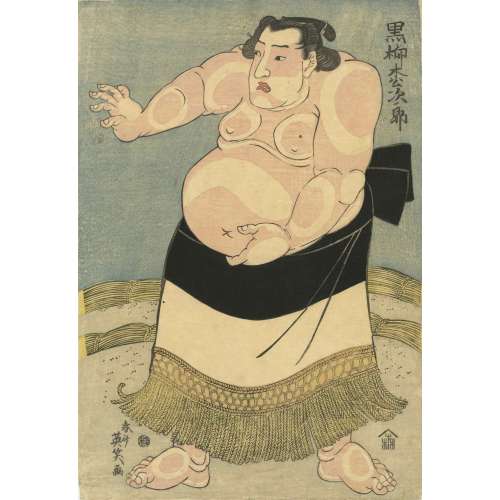 This print was sold to me with the following description: "Ikkansai EISHO (Fl. early 19th c.). A portrait of the wrestler Kuroyanagi Matsujiro, ring name Kumagatake Inosuke. Eisho was a pupil of Eishi. Published c. 1820s by Uoya Eikichi. Signed Shunsai Eisho ga." As a result of our joint effort with my beloved sister, we have so far found the following: The artis is mentioned in The Hotei Encyclopedia of Japanese Woodblock Prints, 2005, Vol 2; p. 438 under the name of Harukawa Eichō. From this source we learned that the artist was active from about 1818 till 1844, and was a print designer in Kyoto. He was a student first of Harukawa Goshichi and later studied in Edo (Tokyo) with Keisai Eisen, when he assumed the art name 'Eichō'. Other names: Shunsai. The Japanese web page dedicated to Harukawa Eichō provides more details: The artist lived from the 4th year of Tenmei ( 1784 ) to the first year of Kaei ( 1848 ). He was a student of Harukawa Goshichi, Kikukawa Eizan as well as of Keisai Eisen. His popular name was Kamenosuke. He was from Kyoto. He took "gagō" (artistic names) of Eishō when he was a student of Harukawa Goshichi; later, when he became a student of Kikukawa Eizan and Keisai Eisen he took the name of Kikukawa Eichō. The artist was mostly known for his bijinga (beautiful women) prints as well as kanazōshi illustrations. Nothing is said anywhere about his sumo prints, though the reference to another Kyushu sumo wrestler portrait has been found. The sumo wrestler Kuroyanagi Matsujiro is also a somewhat obscure figure: information about his life and career is quite inconsistent. It may so happened that two different persons were combined together. Wikipedia page about Aoi Aso Jinja, a Shinto shrine in Hitoyoshi in Kumamoto prefecture, tells us the following:This information has some inconsistencies already. If our hero was born in 1807 and promoted to ōzeki at the age of 32, it should have been the year 1839, not 1847. I found Kumagatake Isuke at "Sumo Reference" website:
This print was sold to me with the following description: "Ikkansai EISHO (Fl. early 19th c.). A portrait of the wrestler Kuroyanagi Matsujiro, ring name Kumagatake Inosuke. Eisho was a pupil of Eishi. Published c. 1820s by Uoya Eikichi. Signed Shunsai Eisho ga." As a result of our joint effort with my beloved sister, we have so far found the following: The artis is mentioned in The Hotei Encyclopedia of Japanese Woodblock Prints, 2005, Vol 2; p. 438 under the name of Harukawa Eichō. From this source we learned that the artist was active from about 1818 till 1844, and was a print designer in Kyoto. He was a student first of Harukawa Goshichi and later studied in Edo (Tokyo) with Keisai Eisen, when he assumed the art name 'Eichō'. Other names: Shunsai. The Japanese web page dedicated to Harukawa Eichō provides more details: The artist lived from the 4th year of Tenmei ( 1784 ) to the first year of Kaei ( 1848 ). He was a student of Harukawa Goshichi, Kikukawa Eizan as well as of Keisai Eisen. His popular name was Kamenosuke. He was from Kyoto. He took "gagō" (artistic names) of Eishō when he was a student of Harukawa Goshichi; later, when he became a student of Kikukawa Eizan and Keisai Eisen he took the name of Kikukawa Eichō. The artist was mostly known for his bijinga (beautiful women) prints as well as kanazōshi illustrations. Nothing is said anywhere about his sumo prints, though the reference to another Kyushu sumo wrestler portrait has been found. The sumo wrestler Kuroyanagi Matsujiro is also a somewhat obscure figure: information about his life and career is quite inconsistent. It may so happened that two different persons were combined together. Wikipedia page about Aoi Aso Jinja, a Shinto shrine in Hitoyoshi in Kumamoto prefecture, tells us the following:This information has some inconsistencies already. If our hero was born in 1807 and promoted to ōzeki at the age of 32, it should have been the year 1839, not 1847. I found Kumagatake Isuke at "Sumo Reference" website:Kuroki Matsujiro (黒木松次郎) was born in the village of Itsuki in Kuma district, Kumamoto prefecture, island of Kyushu in Bunka era, 4th year (1807). Since from his childhood he was blessed by great physique and tough strength. He had affection for sumo. At the age of 18 he became a sumo student of Kumamoto Shimakawa Ikuhei and took the name of Toyama Hidekichi (遠山日出吉). At the age of 23 (1830), he entered sumo stables in Kyoto, mastered the art of taming of young horses, and his talents improved. At the age of 31 he went to Edo, and became a disciple of the ōzeki Oitekaze Kitaro of Hirado domain in Hizen province, also from Kyushu island. After that, he changed his name and became Kuroyanagi Matsujiro (黒柳松次郎 – as on the print). In 1847 (Bunka era, 4th year) he distinguished himself by advancing to the first grade, and at the age of 32 he was promoted to ozeki level, becoming sekitori. After changing his name to Kuma-ga-take Inosuke (熊ヶ嶽猪之介 / くまがたけいのすけ) he displayed further efforts, and became one of the strongmen that fermented sumo wrestling in Edo. In 1853 (Kaei era, 6th year) he retired and returned to his village, becoming an employee as a strongman of Sagara domain (相良藩), and worked hard as instructor of the sumo training hall to train successors until 1855 (Ansei era, 2nd year) when he passed away at the age of 48. Even today Kuma-ga-take's home exists in Itsukimura (his native village). Also, on those grounds a descendant of Kuma-ga-take runs minshuku (guest house) that bears the name of "The Kuroki Pension (lodging) ", and tourists come to visit from various parts of Japan. In 2015, tenth month, within the borders of Aoi Aso Shrine there was built a gravestone publicly honoring Kuma-ga-take Inosuke, sumo wrestler from Edo / of Edo period.
The real name is the same, the ring name Kuroyanagi Matsujiro is the same, however, the date of birth here is 1815. He fought from 1836 till 1853 - which is quite similar to "At the age of 31 he went to Edo, and became a disciple of the ōzeki Oitekaze Kitaro". Though, in 1836 he might be 29 years old. His bouts are listed from spring 1841 to spring 1848 under the name of Kuroyanagi and from winter 1848 till spring 1853 he listed under the name of Kumagatake Isuke [Inosuke].Highest Rank Maegashira 4 Real Name Kuroki Birth Date 1815 Shusshin Kumamoto-ken, Kuma-gun Death Date March 6, 1855 (40 years) Heya Oitekaze Shikona Kuroyanagi Matsujiro - Kumagatake Isuke Hatsu Dohyo 1836.02 (Sandanme) Intai 1853.02 On another important sumo history website, I found that Kuroyanagi first appeared at ring in the spring of 1823 (he might have been 16 years old then, which does not seem right). Then, in the winter tournament of 1848 Kuroyanagi took the name Kumagatake. At the spring tournament of 1853 Kumagatake (Kuroyanagi) retired. This is quite consistent so far.
Then, I found Oitekaze Kitaro, allegedly the teacher of Kuroyanagi.
Everything look good with an exception of ring names (shikona): Kuroyanagi Matsujiro (1823-1828) - Kuroyanagi Sumiemon (1829-30) - Oitekaze Kitaro (1831-1839). May it be that Sato Matsutaro fought under the name of Kuroyanagi Matsujiro until Kuroki Matsujiro took this name from his master? I don't have another explanation of the enigma. What we know is that we have a portrait of a sumo wrestler called Kuroyanagi Matsujiro from Kyushu, but we don't know whether this was the one from Kumamoto (Kumagatake Inosuke, 1807/1815-1855) or the other from Kanagawa (Oitekaze Kitaro, 1799-1865). Subsequently, we may declare that the artist is Shunsai Eishō, a.k.a.Harukawa Eichō from Eishi school (The Hotei Encyclodepdia, p. 524), we can date the print from 1818 to 1844, and only tell that the wrestler is Kuroyanagi Matsujiro from Kyushu (either Kumagatake Inosuke or Oitekaze Kitaro). The publisher of the print is Moriya Jihei (Marks №353, p. 243-5). That's it.Highest Rank Ozeki Real Name SATO Matsujiro (Matsutaro#) Birth Date 1799 Shusshin Kanagawa-ken, Tsukui-gun Death Date May 4, 1865 (66 years) Heya Oitekaze Shikona Kuroyanagi Matsujiro - Kuroyanagi Sumiemon - Oitekaze Kitaro Hatsu Dohyo 1817.10 (Jonokuchi) Intai 1839.03 -
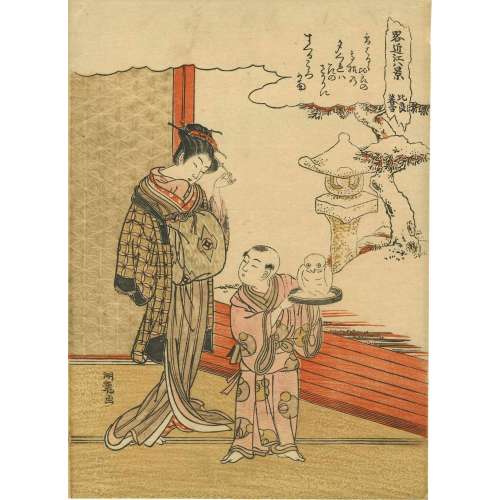 Evening Snow on Mount Hira (Hira no bosetsu), from the series Eight Views of Ōmi in Modern Guise (Ryaku Ōmi hakkei, (略近江八景). About 1773–75 (An'ei 2–4). Artist: Isoda Koryūsai (Japanese, 1735–1790) CATALOGUE RAISONNÉ: Hockley 2003, p. 202, #F-21-1 DIMENSIONS: Vertical chûban; 26 x 19.3 cm (10 1/4 x 7 5/8 in.)Signed: Koryû ga [湖竜画]
Evening Snow on Mount Hira (Hira no bosetsu), from the series Eight Views of Ōmi in Modern Guise (Ryaku Ōmi hakkei, (略近江八景). About 1773–75 (An'ei 2–4). Artist: Isoda Koryūsai (Japanese, 1735–1790) CATALOGUE RAISONNÉ: Hockley 2003, p. 202, #F-21-1 DIMENSIONS: Vertical chûban; 26 x 19.3 cm (10 1/4 x 7 5/8 in.)Signed: Koryû ga [湖竜画]


